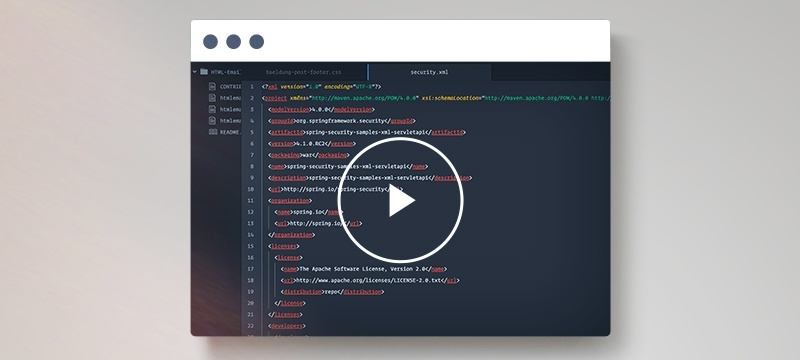1. Overview
This tutorial will show how to retrieve the user details in Spring Security.
The currently authenticated user is available through a number of different mechanisms in Spring. Let’s cover the most common solution first — programmatic access.
A quick guide to track logged in users in an application built using Spring Security.
How to map Roles and Privileges for a Spring Security application: the setup, the authentication and the registration process.
Every app should enable users to change their own password in case they forget it.
2. Get the User in a Bean
The simplest way to retrieve the currently authenticated principal is via a static call to the SecurityContextHolder:
Authentication authentication = SecurityContextHolder.getContext().getAuthentication();
String currentPrincipalName = authentication.getName();
An improvement to this snippet is first checking if there is an authenticated user before trying to access it:
Authentication authentication = SecurityContextHolder.getContext().getAuthentication();
if (!(authentication instanceof AnonymousAuthenticationToken)) {
String currentUserName = authentication.getName();
return currentUserName;
}
There are, of course, downsides to having a static call like this and decreased testability of the code is one of the more obvious. Instead, we’ll explore alternative solutions for this very common requirement.
3. Get the User in a Controller
We have additional options in a @RestController annotated bean.
We can define the principal directly as a method argument, and the framework will correctly resolve it:
@RestController
public class GetUserWithPrincipalController {
@GetMapping(value = "/username")
public String currentUserName(Principal principal) {
return principal.getName();
}
}
Alternatively, we can also use the authentication token:
@RestController
public class GetUserWithAuthenticationController {
@GetMapping(value = "/username")
public String currentUserName(Authentication authentication) {
return authentication.getName();
}
}
The API of the Authentication class is very open so that the framework remains as flexible as possible. Because of this, the Spring Security principal can only be retrieved as an Object and needs to be cast to the correct UserDetails instance:
UserDetails userDetails = (UserDetails) authentication.getPrincipal();
System.out.println("User has authorities: " + userDetails.getAuthorities());
Also, here’s directly from the HTTP request:
@RestController
public class GetUserWithHTTPServletRequestController {
@GetMapping(value = "/username")
public String currentUserNameSimple(HttpServletRequest request) {
Principal principal = request.getUserPrincipal();
return principal.getName();
}
}
Finally, we can use the @AuthenticationPrincipal annotation to get the currently authenticated user details:
@RestController
public class GetUserWithAuthenticationPrincipalAnnotationController {
@GetMapping("/user")
public String getUser(@AuthenticationPrincipal UserDetails userDetails) {
return "User Details: " + userDetails.getUsername();
}
}
Here, the @AuthenticationPrincipal annotation injects the currently authenticated user’s UserDetails into the method. This annotation helps resolve Authentication.getPrincipal() to a method argument.
Additionally, when we annotate a method parameter with @AuthenticationPrincipal, Spring Security automatically provides the principal of the currently authenticated user. The principal represents the user’s identity, which can be the username, a user object, or any form of user identification.
4. Get the User via a Custom Interface
To fully leverage the Spring dependency injection and be able to retrieve the authentication everywhere, not just in @RestController beans, we need to hide the static access behind a simple facade:
public interface IAuthenticationFacade {
Authentication getAuthentication();
}
@Component
public class AuthenticationFacade implements IAuthenticationFacade {
@Override
public Authentication getAuthentication() {
return SecurityContextHolder.getContext().getAuthentication();
}
}
The facade exposes the Authentication object while hiding the static state and keeping the code decoupled and fully testable:
@RestController
public class GetUserWithCustomInterfaceController {
@Autowired
private IAuthenticationFacade authenticationFacade;
@GetMapping(value = "/username")
public String currentUserNameSimple() {
Authentication authentication = authenticationFacade.getAuthentication();
return authentication.getName();
}
}
5. Get the User in JSP
We can access the currently authenticated principal from JSP pages by leveraging the Spring Security Taglib support.
First, we need to define the tag on the page:
<%@ taglib prefix="security" uri="http://www.springframework.org/security/tags" %>
Next, we can refer to the principal:
<security:authorize access="isAuthenticated()">
authenticated as <security:authentication property="principal.username" />
</security:authorize>
6. Get the User in Thymeleaf
Thymeleaf is a modern, server-side web templating engine with good integration with the Spring MVC framework.
Let’s see how to access the currently authenticated principal on a page with the Thymeleaf engine.
First, we need to add the thymeleaf-spring5 and the thymeleaf-extras-springsecurity5 dependencies to integrate Thymeleaf with Spring Security:
<dependency>
<groupId>org.thymeleaf.extras</groupId>
<artifactId>thymeleaf-extras-springsecurity6</artifactId>
</dependency>
<dependency>
<groupId>org.thymeleaf</groupId>
<artifactId>thymeleaf-spring5</artifactId>
</dependency>
Now we can refer to the principal in the HTML page using the sec:authorize attribute:
<html xmlns:th="https://www.thymeleaf.org"
xmlns:sec="https://www.thymeleaf.org/thymeleaf-extras-springsecurity5">
<body>
<div sec:authorize="isAuthenticated()">
Authenticated as <span sec:authentication="name"></span></div>
</body>
</html>
7. Conclusion
This article showed how to get the user information in a Spring application, starting with the common static access mechanism, followed by several better ways to inject the principal.
As always, the implementation of these examples can be found over on GitHub. This is an Eclipse-based project, so it should be easy to import and run as it is. When running the project locally, we can access the homepage HTML here:
http://localhost:8080/spring-security-rest-custom/foos/1





